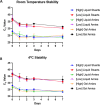Validation of a qualitative real-time PCR assay for the detection of Candida auris in hospital inpatient screening
- PMID: 38690882
- PMCID: PMC11237412
- DOI: 10.1128/jcm.00158-24
Validation of a qualitative real-time PCR assay for the detection of Candida auris in hospital inpatient screening
Abstract
Candida auris is a multidrug-resistant opportunistic fungal pathogen capable of causing serious infections and healthcare-associated outbreaks. Screening for colonization with C. auris has become routine and is recommended in many hospitals and healthcare facilities as an infection control and prevention strategy. Subsequently, and since there are currently no FDA-approved tests for this purpose, clinical microbiology laboratories have become responsible for developing protocols to detect C. auris using axial and inguinal screening swabs. In a College of American Pathologists-accredited large academic healthcare center setting, we implemented a laboratory-developed nucleic-acid amplification test for the detection of C. auris DNA. Our test validation evaluated the performance of the DiaSorin C. auris primer set used in a real-time qualitative PCR assay on the LIAISON MDX thermocycler with the Simplexa Universal Disc. The assay was highly sensitive and specific, with a limit of detection of 1-2 CFU/reaction, with no observed cross-reactivity with other Candida spp., bacterial skin commensal organisms or commonly encountered viruses. When run in parallel with a culture-based detection method, the PCR assay was 100% sensitive and specific. The assay was precise, with low variability between replicates within and between runs. Lastly, pre-analytical factors, including swab storage time, temperature, and transport media, were assessed and found to have no significant effect on the detection of C. auris at variable concentrations. Taken together, this study expands the available options for nucleic acid detection of C. auris and characterizes pre-analytical factors for implementation in both high- and low-volume laboratory settings.
Importance: This study overviews the validation and implementation of a molecular screening tool for the detection of Candida auris in a College of American Pathologist-accredited clinical laboratory. This molecular laboratory-developed test is both highly sensitive and specific and has significant health-system cost-savings associated with significantly reduced turn-around-time compared to traditional standard-of-care culture-based work up. This method and workflow is of interest to support clinical microbiology diagnostics and to help aid in hospital inpatient, and infection prevention control screening.
Keywords: Candida auris; hospital infections; infectious disease; molecular methods; mycology; public health.
Conflict of interest statement
The authors declare no conflict of interest.
Figures


Similar articles
-
Performance characteristics of an automated, high-throughput RT-PCR assay for the detection of Candida auris on 3-point and nasal swabs.Microbiol Spectr. 2025 Apr;13(4):e0211424. doi: 10.1128/spectrum.02114-24. Epub 2025 Feb 14. Microbiol Spectr. 2025. PMID: 39950809 Free PMC article.
-
Development and Validation of a Real-Time PCR Assay for Rapid Detection of Candida auris from Surveillance Samples.J Clin Microbiol. 2018 Jan 24;56(2):e01223-17. doi: 10.1128/JCM.01223-17. Print 2018 Feb. J Clin Microbiol. 2018. PMID: 29187562 Free PMC article.
-
A simple and sensitive test for Candida auris colonization, surveillance, and infection control suitable for near patient use.J Clin Microbiol. 2024 Jul 16;62(7):e0052524. doi: 10.1128/jcm.00525-24. Epub 2024 Jun 18. J Clin Microbiol. 2024. PMID: 38888304 Free PMC article.
-
Diagnosis, management and prevention of Candida auris in hospitals: position statement of the Australasian Society for Infectious Diseases.Intern Med J. 2019 Oct;49(10):1229-1243. doi: 10.1111/imj.14612. Intern Med J. 2019. PMID: 31424595 Review.
-
Candida auris Diagnostics: Identification and Screening.Clin Lab Med. 2025 Mar;45(1):101-110. doi: 10.1016/j.cll.2024.10.005. Epub 2024 Dec 12. Clin Lab Med. 2025. PMID: 39892930 Review.
Cited by
-
Characterization and Differentiation of Candida auris on Dixon's Agar Using Raman Spectroscopy.Pathogens. 2024 Nov 8;13(11):978. doi: 10.3390/pathogens13110978. Pathogens. 2024. PMID: 39599531 Free PMC article.
-
Antifungal and Antioxidant Activity of Thiourea Derivatives Against Nosocomial Candida auris Strains Isolated in Romania.Molecules. 2025 Apr 9;30(8):1675. doi: 10.3390/molecules30081675. Molecules. 2025. PMID: 40333579 Free PMC article.
-
Diagnostic Approaches for Candida auris: A Comprehensive Review of Screening, Identification, and Susceptibility Testing.Microorganisms. 2025 Jun 24;13(7):1461. doi: 10.3390/microorganisms13071461. Microorganisms. 2025. PMID: 40731971 Free PMC article. Review.
-
Current Updates on Molecular Diagnostic Assays Used for Detection of Candida auris: A Systematic Review.Diagnostics (Basel). 2025 Jan 9;15(2):140. doi: 10.3390/diagnostics15020140. Diagnostics (Basel). 2025. PMID: 39857024 Free PMC article. Review.
-
Candida auris Updates: Outbreak Evaluation through Molecular Assays and Antifungal Stewardship-A Narrative Review.Curr Issues Mol Biol. 2024 Jun 15;46(6):6069-6084. doi: 10.3390/cimb46060362. Curr Issues Mol Biol. 2024. PMID: 38921033 Free PMC article. Review.
References
Publication types
MeSH terms
Substances
LinkOut - more resources
Full Text Sources
Medical
Miscellaneous

